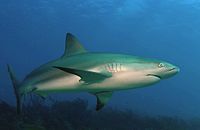
Photo from wikipedia
Abstract Teeth are an integral component of feeding ecology, with a clear link between tooth morphology and diet, as without suitable dentition prey cannot be captured nor broken down for… Click to show full abstract
Abstract Teeth are an integral component of feeding ecology, with a clear link between tooth morphology and diet, as without suitable dentition prey cannot be captured nor broken down for consumption. Bull sharks, Carcharhinus leucas, undergo an ontogenetic niche shift from freshwater to marine habitats, which raises the question: does tooth morphology change with ontogeny? Tooth shape, surface area and thickness were measured using both morphometrics and elliptic Fourier analysis to determine if morphology varied with position in the jaw and if there was an ontogenetic change concordant with this niche shift. Significant ontogenetic differences in tooth morphology as a function of position in the jaw and shark total length were found, with upper and lower jaws of bull sharks presenting two different tooth morphologies. Tooth shape and thickness fell into two groupings, anterior and posterior, in both the upper and lower jaws. Tooth surface area, however, indicated three groupings, mesial, intermediate and distal, in both the upper and lower jaws. While tooth morphology changed significantly with size, showing an inflection at sharks of 135 cm total length, each morphological aspect retained the same tooth groupings throughout. These ontogenetic differences in tooth morphologies reflect tooth strength, prey handling and heterodonty.
Journal Title: Journal of Fish Biology
Year Published: 2022
Link to full text (if available)
Share on Social Media: Sign Up to like & get
recommendations!